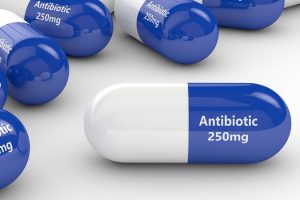Antibacterials Industry Pipeline Slows to Trickle

Fewer than half of the antibiotics companies that have gone public in the past decade remain active today, according to research from an industry organization.
The reduced number of active antibiotics companies is one of several key findings in a report from the Biotechnology Innovation Organization (BIO), a global trade association representing biotechnology companies, academic institutions, state biotechnology centers, and related organizations.

David Thomas
Although the 20th century yielded more than 90% of all antibacterial drugs that resulted in a significant reduction in deaths from bacterial infections, the 21st century continues to present challenges with respect to drug effectiveness and future drug development, according to authors David Thomas, CFA, BIO’s vice president for industry research, and Chad Wessel, BIO’s director of industry research and policy analysis.
“More than 1.2 million people worldwide are dying each year from antibiotic resistant infections, and it is estimated this number will grow to 10 million per year by 2050,” they write.
For the report, the authors examined recent investments in antibacterial innovation and the current clinical pipeline. They defined antibacterials as direct-acting therapeutics that either kill bacteria or stop bacterial growth and as indirect-acting therapeutics that either boost the effectiveness of direct-acting drugs or inhibit the exotoxins secreted by bacteria. Types of antibacterials considered in the report include small molecules, proteins, nucleic acids, bacteriophages, and live bacteria, as well as microbiomes to prevent target organism growth.
Stagnant Growth
The current clinical pipeline of antibacterial drugs is inadequate to meet the challenges of drug-resistant bacteria, the authors say. Notably, during the past 35 years, the US Food and Drug Administration (FDA) has approved only one new chemical entity that acts directly on a molecular target, they add. The number of clinical trials for new antibacterials also declined, with a 33% drop between the periods 2016–2020 and 2011–2015.
Future Improvements
Small companies appear to be key to the future of antibacterials, according to the report. Of the therapies currently in clinical trials, 81% were developed by small biotech companies.
Since 2011, more than 16% of antibiotics in early-stage clinical trials received FDA approval, compared to the 7.9% overall success rate of therapies across all diseases. The relatively high rate of approval for antibacterials over the past decade compared to other diseases occurred despite a low amount of venture capital funding, the authors note. Over the past decade, venture capital funding for antibiotic development in the United States was approximately $1.6 million, compared to $26.5 billion for oncology.
Why It Matters
“This report comes at a time when two bipartisan pieces of legislation, the PASTEUR Act and the DISARM Act, are under consideration in Congress,” said lead author Thomas in an interview. “These bills would help address some of the unique market challenges for antibacterials by establishing new economic incentives and reforming reimbursement mechanisms,” he said.
Thomas described the legislation for Medscape Medical News.
“PASTEUR would establish a subscription-style model for new antimicrobials to stimulate much-needed research and development [R&D] into the pipeline of novel antimicrobials. The government would pay up front for access to certain novel antimicrobials, thus decoupling payments from the volume of sales of those treatments. DISARM would remove barriers to patient access for novel antimicrobial products by modernizing how Medicare reimburses hospitals for antimicrobials that treat serious and life-threatening infections,” he said.
“We hope that this new report will help reinforce why there is such an urgent need to enact policy reforms to stabilize and sustain the antibacterial ecosystem,” he added.
Thomas said he was surprised by the high success rates of antibacterials compared to medicines for other types of diseases. “For example, oncology medications in phase 1 clinical trials have a near 5% probability of FDA approval, while antibacterials have a 16% probability of receiving approval,” he said. “Compared to the entire industry, antibacterials have twice the calculated success rate. This indicates that early innovation is not the limiting factor for this subsector, but instead the limitations exist after FDA approval because of the unique — and broken — marketplace for antibacterials,” he emphasized.
The take-home message for clinicians is that the antibacterial pipeline is “incredibly thin,” Thomas said. “For instance, of the 72 drug programs in the antibacterial clinical development pipeline, 16 target just one bacterium, C difficile. By comparison, there are 3315 new chemical entity drug programs in the oncology clinical pipeline, with 160 of those for breast cancer alone,” he noted.
“COVID-19 also offers a telling comparison for how narrow the antibacterial pipeline is,” said Thomas. “There were over 400 drugs targeting COVID-19 in clinical trials in less than 2 years. Meanwhile, some singular bacterial pathogens only have one or two drugs in the pipeline, even though drug-resistant pathogens are spreading rapidly. We simply do not have enough drugs in development to combat them,” Thomas emphasized.
Although an increase in basic research would help to identify new pathogens to target with antibacterials, a more robust pipeline is needed, “with more diversity in the modalities and chemical structures of drugs being developed to ensure we can treat the most dangerous bacteria,” said Thomas. “To get to that point, we need substantially more investment in this space, which requires new policy solutions to address the broken market described in the study,” he said.
Coordinated Action Is Lacking
“Especially with attention drawn to the pandemic, the march of antimicrobial resistance continues,” said Paul G. Auwaerter, MD, of Johns Hopkins University, Baltimore, in an interview. “Unlike the pandemic, there is no major coordinated response among government, regulatory authorities, industry, and nongovernmental organizations to address the crisis in evolution here in the United States or worldwide,” said Auwaerter, who serves as clinical director of the Division of Infectious Diseases at Johns Hopkins.

Dr Paul Auwaerter
Auwaerter said he was not surprised by the findings in the report. “We don’t have drugs with new mechanisms of action to stay safely ahead of antimicrobial evolution,” he said. “Compared to the past, major pharmaceutical companies are not investing in this space’s research and development,” he added. Small companies benefited from R&D support from Biomedical Advanced Research and Development Authority, but even the drugs that make it to the marketplace cannot ensure the survival of small firms because of limited demand and market forces, because “we try to save these precious drugs for those in need,” he said.
Asked how industry might balance innovation by giving more attention to the problem of antimicrobial resistance, Auwaerter responded, “I can only see it if there are guaranteed incentives or a market that would make the risk of R&D favorable to a corporation.” He added, “This would take political vision and will, since pharma doesn’t have the best public reputation. However, the example of the pandemic offers some hope that, with governmental backing in some fashion, a steady market for innovative antimicrobials could be developed.”
Additional research is needed to develop effective antimicrobials with novel mechanisms of action, Auwaerter said. There is also “the need to maintain and [to] grow researchers involved in this field’s R&D [as well as] clinical trials. We’ve had a critical brain drain over the last two decades,” he emphasized.
The report was funded by Biotechnology Innovation Organization. Thomas has disclosed no relevant financial relationships. Auwaerter has served as a consultant for EMD Serono, Shionogi, and Pfizer and owns stock in JNJ.
For more news, follow Medscape on Facebook, Twitter, Instagram, and YouTube.
Source: Read Full Article




